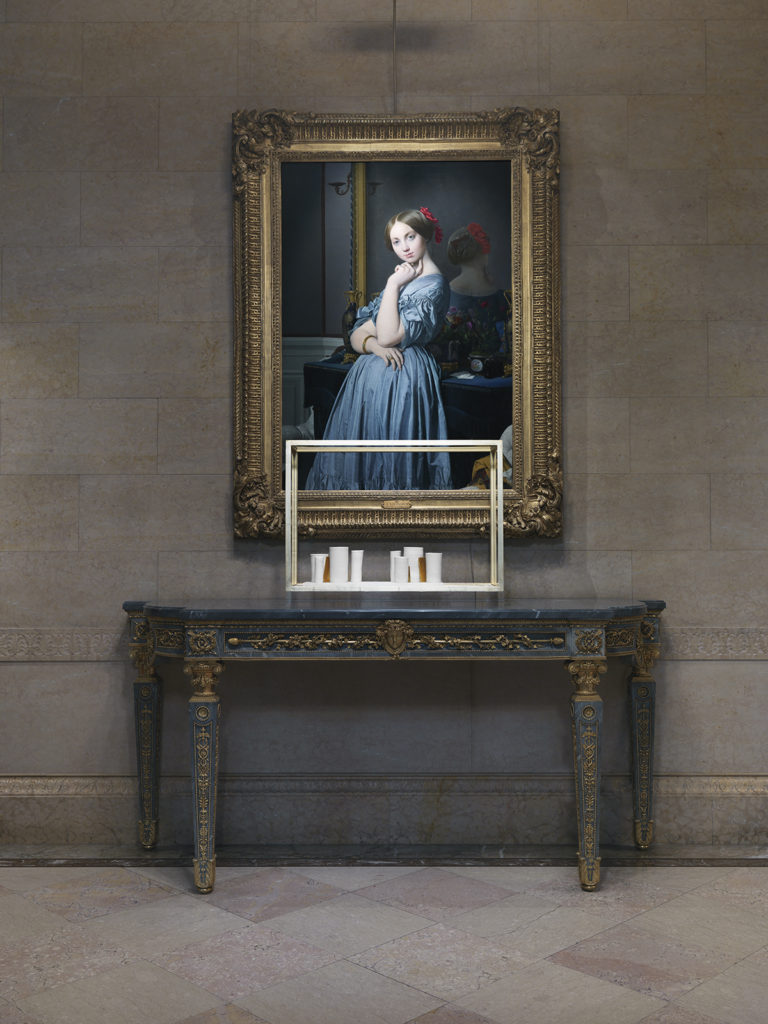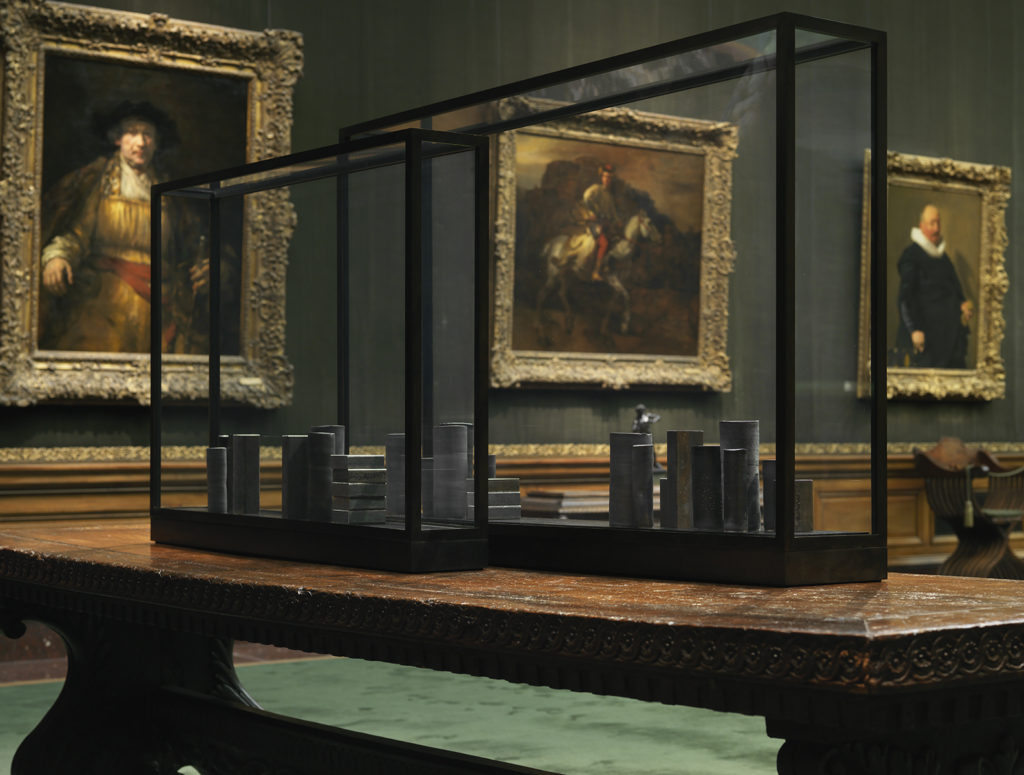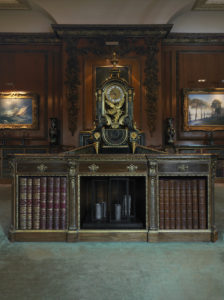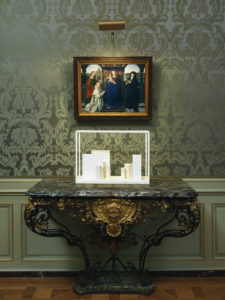Art in NYC: Elective Affinities – Edmund De Waal At The Frick Collection
Site-specific temporary installations in porcelain, steel, and glass by the sculptor Edmund de Waal are displayed in the main galleries of the Frick from May 30 – November 17, 2019

Renown for its exquisite assortment of the works by old masters, the Frick Collection presents the arrangements Elective Affinities by the modern sculptor and author Edmund de Waal. The prior success of De Waal’s – installations at the historic sites alongside his passion for porcelain and its history and his fascination about the diaspora and memoir make the gilded halls of the Frick Museum a perfect space to showcase his art. He is the first living artist invited to exhibit there.
Inspired by the museum collection of grand works by Gainesboro, Fragonard, Goya, and Ingres, de Waal’s minimalist installations augment the permanent collection and shine new light on its significance.
The elegance of the Elective Affinities opens a new perspective on the meaning of art and the power of inspiration. Adding fluidity and minimalism of expression, the installations bring well-fitting modernity to the time tested artworks.
Pace your way through the main halls of the Frick allowing for some extra time in each gallery to absorb de Waal’s stories behind each arrangement while contemplating on the continuity of art over the four centuries. The exhibition is accompanied by the passionate and exciting audio narration by the artist. Audio stories can be found on the museum website.
Stay in the know about future events and offers by subscribing to ARTS-NY newsletter Subscribe

Edmund de Waal is a British artist and author. He is known for the large scale porcelain installations in the historical settings and pottery works. His elegant pottery pieces with slightly dented sides in a variety of subtle earthy tones earned him wide recognition with the solo exhibitions around the world. A scholar of Japanese language and history, he traveled to Japan to study at the Mejiro Ceramics studio. After returning to Britain, he started making the pottery and later became a Professor of Ceramics at the University of Westminster. In 2012, he received his first public art commission for the Alison Richard Building at the Sidgwick Site of the University of Cambridge, where he created A Local History, consisting of three vitrines filled with porcelain to sit beneath the pavement surrounding the building.
Before partnering with the Frick museum, de Waal has made major installations for Chatsworth, Kettle’s Yard, Tate Britain, Fitzwilliam Museum and the Victoria and Albert Museum. In 2014, he created two further public commissions: a series of towers for the retrochoir at Southwark Cathedral called Another Hour; and Lichtzwang (‘light-duress’, after a poetry collection by Paul Celan), a pair of 9 ft tall vitrines containing 281 white and cream porcelain vessels, commissioned by the Kunsthistorisches Museum in Vienna for the Theseus Temple in the Volksgarten.

De Waal’s highly acclaimed family memoir The Hare with Amber Eyes: a Hidden Inheritance published in 2010 earned the Costa Book Award for biography in 2010, as well as the Galaxy New Writer of the Year Book Award and the Royal Society of Literature‘s Ondaatje Prize. The book traces the history of his Jewish ancestors (on his paternal grandmother side) mixing places, cultures, works of art, and the universal human connections.

The Frick galleries and its rich collection of the gilded art create a perfect setting for de Waal’s arrangements in porcelain, steel, and glass. The light-inspired pairings of the modern compositions and the permanent art from the Frick collection complement each other and accentuate the depth of the works. De Waal’s white and gold garnitures are perfectly attuned to the baroque rooms’ decor. In the dining room which is dominated by two large portraits by Gainesboro, on living in an old country I and II are all about Englishness in the author’s words. On an archaic torso of Apollo situated in the Fragonard room, the garniture meshes up with the ease and lightness which evokes France and disappears among cupids, dancers, and lovers.
In the West Gallery, the main exhibition halls of the museum where Spanish, Dutch and Flemish old masters are housed, de Waal chooses black porcelain and steel for his compositions. They are surrounded by the Dutch Gilded age portraits of wealthy citizens risen to power and prosperity because of the world dominance in trade and Naval advances. The Dutch East India company ruled the seas and the world trade for two centuries from the early 17th century. It brought the porcelain to Europe from China thus making de Waal’s porcelain entreaties very appropriate in the setting. Repetition, pride, and power already fill the space. The modern arrangements only add the imaginary sound of force and intensity.
In the Library overlooked by the portrait of Henry Clay Frick by John C. Johansen, de Waal discreetly places his arrangement an alchemy in back porcelain and steel among the old books about wealth on the lower shelf of the table in the center. The arrangement is inspired by the transformation of steel into wealth, and wealth into art which is at the heart of Frick family story. De Waal’s works continue this process in the present time.

Arguably the highest point in the exhibition is the floating installation that pause of space in the North Hall. Spanning over the four centuries in time from the 17th-century Gouthière’s grey-blue marble with gilded bronze French side table situated under the 19th-century portrait of Comtesse d’Haussonville by Jean-Auguste-Dominique Ingres is de Waal’s garniture that pause of space (2019). Marvelously matching the colors and ascents in Ingres’ painting and the decorative table, its a reminder of the timelessness of beauty.
The Frick Collection, a renown museum and research center of the art of Old Masters, is famed for its collection of European paintings and decorative art objects. The Museum was opened in 1935 in the New York City residence of industrialist Henry Clay Frick. Along with its magnificent permanent collection and special exhibitions, the Frick offers a wide range of lectures, symposia, education programs, and an acclaimed concert series. Elective Affinities: Edmund De Waal At The Frick Collection is on view from May 30 – November 17, 2019.
Stay in the know about future events and offers by subscribing to ARTS-NY newsletter Subscribe
Date: May 30 – November 17, 2019
Venue: The Frick Collection, 1 East 70th Street, New York, NY
One thought to “Art in NYC: Elective Affinities – Edmund De Waal At The Frick Collection”
Comments are closed.